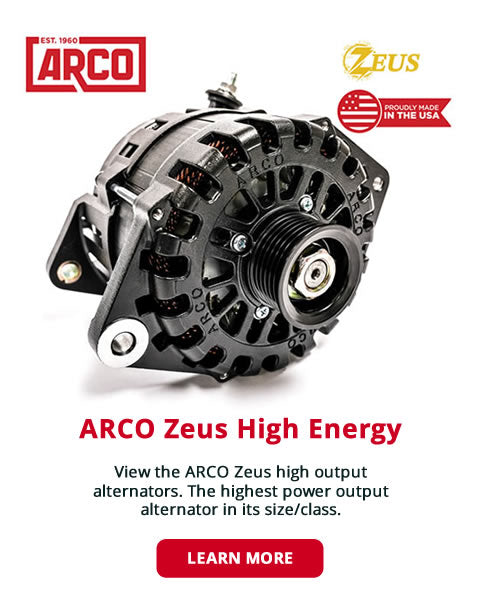What you need to know about Charging Systems, by ARCO Marine
Not
NOTE: ALTERNATORS ARE NOT BATTERY CHARGERS
ENGINE HORSEPOWER REQUIRED FOR ALTERNATORS
For every 23 AMPS of alternator output about one horsepower is required. For Example: A 12 volt, 115 AMP alternator requires 5 horsepower. (115 divided by 23 = 5 horsepower). A 24 volt unit requires twice the horsepower.
ALTERNATORS ARE NOT BATTERY CHARGERS
Alternators are designed to supply current for the accessory load and maintain the charge of the battery. Most alternators can safely charge at only two-thirds of their maximum rated output. When trying to recharge a dead battery, the alternator will charge at maximum output for extended periods of time causing the alternator to overheat. High heat destroys transistors, diodes and windings.
ONE-WIRE ALTERNATORS CAN NOT BE USED WITH BATTERY ISOLATORS
One-wire alternators, sometimes referred to as self-exciting alternators, require battery voltage at the output terminal in order to charge. Since battery isolators eliminate the battery voltage to the alternator, you must use a battery isolator with an ignition excite capability or modifications must be made to the alternator to allow ignition excitation.
 ALTERNATORS MUST TURN THE PROPER RPM IN ORDER TO FUNCTION
ALTERNATORS MUST TURN THE PROPER RPM IN ORDER TO FUNCTION
Just because the alternator looks like it's turning, doesn't mean it's turning fast enough to charge. Most alternators do not start charging until they reach 1,000 RPM alternator shaft speed. 5,000 RPM alternator shaft speed is normally required to reach maximum output. If you're not sure what the alternator shaft speed is, you can determine this with the pulley ratio. Measure the diameter of the crank shaft or drive pulley or the alternator pulley. Divide the crank shaft pulley diameter by the alternator pulley diameter. This figure would be the engine-to-alternator RPM ratio. A normal ratio would be 2.5 to 1. For example, let's say we have a 7 inch diameter crank shaft pulley and a 2.75 inch alternator pulley. We would divide 7 inches by 2.75 which equals 2.54 to 1. If the engine was turning 1,000 RPM we would multiply 1,000 by 2.54 which would give us 2,540 alternator RPM. Again, with today's high amperage alternators, belt condition and tension are critical in proper alternator performance.
IF YOU ARE ABLE TO TURN THE ALTERNATOR FAN BY HAND, YOU DO NOT HAVE THE BELT TIGHT ENOUGH
ALTERNATORS WILL CHARGE WHEN TURNING IN EITHER DIRECTION
NEVER DISCONNECT THE BATTERY CABLE WHEN THE ALTERNATOR IS CHARGING
A common practice with the old generator system was to disconnect the battery cable while the engine was running to see if the generator was working. If this procedure is done on today's transistorized alternator systems, severe damage to the internal components of the alternator usually will be the end results. THIS INCLUDES USING A BATTERY SELECTOR SWITCH WHILE THE ENGINE IS RUNNING.
You can view and download our Charging Systems Tech Tip sheet HERE, or view our full list of Tech Tips HERE.
You can also visit the ARCO Marine YouTube Channel HERE.


